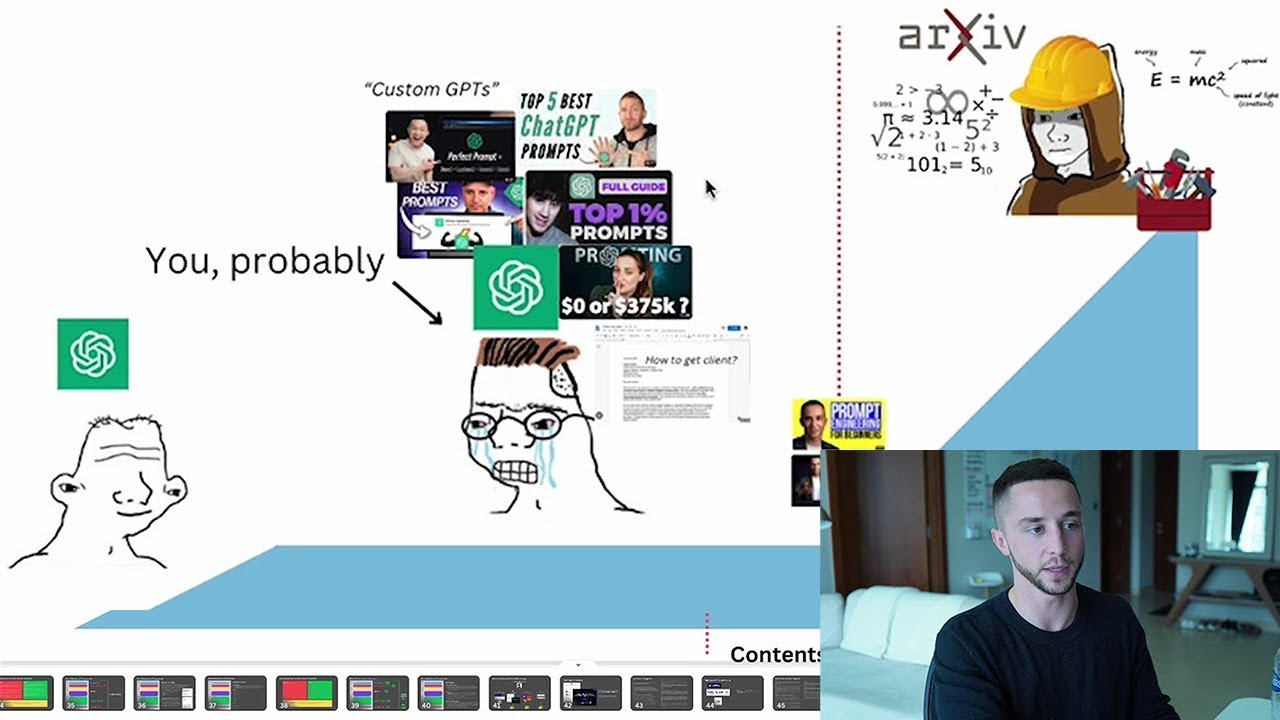Google's 9 Hour AI Prompt Engineering Course In 20 Minutes
Summary
TLDRThis video explains the core principles behind creating AI agents for different purposes, based on a Google prompting course. It focuses on two types of agents: Agent Sim, a simulation tool for practicing real-life scenarios like interviews and career development, and Agent X, a feedback provider that offers personalized critique on professional tasks like pitching. The course emphasizes how to design these agents by defining their persona, context, and task, and includes practical examples of how these agents can be used for training or consulting. The aim is to teach users how to create effective AI-driven learning and feedback experiences.
Takeaways
- 😀 Agent Sim is a simulation-based AI that helps improve interview skills by role-playing various professional scenarios.
- 😀 Agent X provides personalized feedback as a consultant or tutor on a wide range of topics, helping you refine your skills.
- 😀 To create effective AI agents, define a clear persona (e.g., career coach or fitness trainer) that the AI will take on.
- 😀 Providing detailed context is essential when setting up an AI agent. The more information you give, the better the agent can assist you.
- 😀 Set clear goals for the conversation, such as improving communication skills, practicing specific tasks, or receiving expert critique.
- 😀 Use a 'stop phrase' (e.g., 'jazz hands') to signal the end of a conversation or role-play session with the AI.
- 😀 After each session, the AI should provide a summary and feedback to help you understand areas of improvement.
- 😀 The course emphasizes creating agents that are tailored to specific professional development scenarios, like improving interview performance.
- 😀 Both Agent Sim and Agent X can guide you through real-world situations, like pitching ideas or refining business presentations.
- 😀 The overall objective is to simulate realistic scenarios that help individuals practice and enhance their skills in a safe, interactive way.
Q & A
What are the two types of AI agents discussed in the script?
-The two types of AI agents discussed are Agent Sim and Agent X. Agent Sim is a simulation agent used for role-playing scenarios, like practicing interviews. Agent X is an expert feedback agent that provides personalized critique on various topics.
How does Agent Sim assist in the learning process?
-Agent Sim assists by simulating scenarios, such as mock interviews or role-playing, to help users improve specific skills like communication, articulating strengths, and discussing career goals. The user can practice interacting with the agent in a controlled environment, receiving feedback and guidance.
What is the 'stop rule' used in Agent Sim simulations?
-The stop rule is a phrase, specifically 'jazz hands,' that the user can say to signal the end of the simulation. After this, Agent Sim provides feedback and key takeaways for the user to work on.
What role does the 'Persona' play in creating an AI agent?
-The Persona defines the character the AI agent will take on during interactions. For example, an agent could take the persona of a fitness trainer, HR professional, or client. The Persona sets the tone for the conversation and the skills the agent will focus on helping the user develop.
What kind of feedback does Agent X provide?
-Agent X provides personalized feedback on any topic, acting as a consultant or tutor. It critiques answers, asks follow-up questions, and provides advice to improve the user's performance in the chosen task, such as pitching a creative campaign.
How is context important when setting up an AI agent?
-Context is crucial because it defines the situation and the type of conversation the AI agent will have. For example, if the agent is simulating an interview scenario, the context will include details about the company, the job role, and the type of conversation the intern should focus on.
What is the purpose of providing a detailed scenario in the AI agent setup?
-Providing a detailed scenario ensures the AI agent has enough information to guide the conversation effectively. It allows the agent to simulate realistic situations, provide appropriate feedback, and tailor its responses to the specific learning goals of the user.
Why is it important to set rules for the AI agent's interactions?
-Setting rules helps guide the conversation and keeps it focused on specific learning objectives. For example, asking the agent to inquire about a user's workout routine and meal planning ensures the interaction stays on track for the user's fitness goals.
What happens after the user finishes an interaction with Agent X?
-After the user finishes, Agent X provides a summary of the conversation, highlighting areas where the user can improve. It also suggests additional material or references to help the user further enhance their skills.
How does the course help users retain the information about creating AI agents?
-The course helps users retain the information by offering an assessment at the end, where users are encouraged to review key concepts and demonstrate their understanding. The course also includes practical examples and detailed instructions for creating and interacting with AI agents.
Outlines

This section is available to paid users only. Please upgrade to access this part.
Upgrade NowMindmap

This section is available to paid users only. Please upgrade to access this part.
Upgrade NowKeywords

This section is available to paid users only. Please upgrade to access this part.
Upgrade NowHighlights

This section is available to paid users only. Please upgrade to access this part.
Upgrade NowTranscripts

This section is available to paid users only. Please upgrade to access this part.
Upgrade NowBrowse More Related Video

why you suck at prompt engineering (and how to fix it)

I Was Prompting AI Agents Wrong... Until I Learned This (Live Prompting Examples)

How To Use Ellevenlabs AI Agent (Conversational AI Agent Tutorial)

DAS PENAS - DIREITO PENAL

NotebookLM: The AI Notebook That Transforms How You Study

Google's NEW Agent2Agent Protocol
5.0 / 5 (0 votes)